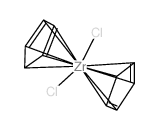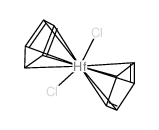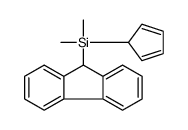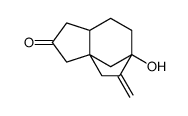Lithium Cyclopentadienide
Modify Date: 2024-01-02 13:03:35

Lithium Cyclopentadienide structure
|
Common Name | Lithium Cyclopentadienide | ||
|---|---|---|---|---|
| CAS Number | 16733-97-4 | Molecular Weight | 72.03420 | |
| Density | N/A | Boiling Point | N/A | |
| Molecular Formula | C5H5Li | Melting Point | N/A | |
| MSDS | Chinese USA | Flash Point | N/A | |
| Symbol |

GHS05 |
Signal Word | Danger | |
| Name | Lithium Cyclopentadienide |
|---|---|
| Synonym | More Synonyms |
| Molecular Formula | C5H5Li |
|---|---|
| Molecular Weight | 72.03420 |
| Exact Mass | 72.05510 |
| LogP | 1.45020 |
| Appearance of Characters | Powder | off-white |
| Water Solubility | Insoluble in water. |
|
Section 1: Product Identification Chemical Name:Lithium cyclopentadienide, 97% CAS Registry Number:16733-97-4 Formula:C5H5Li EINECS Number:none Chemical Family:metallocene Synonym:Cyclopentadienyl lithium
Section 2: Composition and Information on Ingredients IngredientCAS NumberPercentACGIH (TWA)OSHA (PEL) Title Compound16733-97-4100%no datano data Section 3: Hazards Identification Dust or vapors are corrosive and may be toxic if inhalaed, swallowed or contacted with the skin. Lithium Emergency Overview: compounds are toxic to the central nervous system and may damage kidneys and act as a teratogen. Primary Routes of Exposure:Ingestion, inhalation, skin, eyes. Eye Contact:Causes burns to the eyes. Skin Contact:Causes burns to the skin. Inhalation:Dust corrosive to mucous membranes and respiratory tract. Vapors may be toxic. Ingestion:Ingestion may cause burns to the mouth, throat, and esophagus. May be toxic. Corrosive to skin, eyes and respiratory tract. Ingestion may cause vomiting, diarrhea, kidney injury and central Acute Health Affects: nervous system depression. Chronic effects of exposure to lithium compounds include kidney damage, gastrointestinal disturbances, Chronic Health Affects: fatigue, and thyroid damage. May be a teratogen. NTP:No IARC:No OSHA:No SECTION 4: First Aid Measures Immediately flush the eyes with copious amounts of water for at least 10-15 minutes. A victim may need Eye Exposure: assistance in keeping their eye lids open. Get immediate medical attention. Wash the affected area with water. Remove contaminated clothes if necessary. Seek medical assistance if Skin Exposure: irritation persists. Remove the victim to fresh air. Closely monitor the victim for signs of respiratory problems, such as difficulty Inhalation: in breathing, coughing, wheezing, or pain. In such cases seek immediate medical assistance. Seek medical attention immediately. Keep the victim calm. Give the victim water (only if conscious). Induce Ingestion: vomiting only if directed by medical personnel. SECTION 5: Fire Fighting Measures Flash Point:no data Autoignition Temperature:Unknown Explosion Limits:Unknown Extinguishing Medium:dry chemical only. Fire fighters should be equipped with a NIOSH approved positive pressure self-contained breathing apparatus Special Fire Fighting Procedures: and full protective clothing. Hazardous Combustion andFlammable. If involved in a fire this material may release toxic and corrosive fumes. Decomposion Products: Unusual Fire or Explosion Hazards: Water liberates cyclopentadiene, a toxic, flammable liquid SECTION 6: Accidental Release Measures Remove ignition sources. Small spills can be mixed with vermiculite, sodium carbonate or other suitable non Spill and Leak Procedures: combustible adsorbent and swept up. SECTION 7: Handling and Storage Handling and Storage:Handle and store the material under an inert dry atmosphere of nitrogen or argon. Keep away from heat. SECTION 8: Exposure Controls and Personal Protection Eye Protection:Always wear approved safety glasses when handling a chemical substance in the laboratory. Skin Protection:Wear protective clothing and gloves. Consult with glove manufacturer to determine the proper type of glove. Ventilation:Handle the material in an efficient fume hood. If ventilation is not available a respirator should be worn. The use of respirators requires a Respirator Respirator: Protection Program to be in compliance with 29 CFR 1910.134. Ventilation:Handle the material in an efficient fume hood. Additional Protection:No additional protection required. SECTION 9: Physical and Chemical Properties Color and Form:off-white pwdr. Molecular Weight:72.04 Melting Point:no data Boiling Point:no data Vapor Pressure:not applicable Specific Gravity:no data Odor:Irritating pine oil odor Solubility in Water:reacts with water SECTION 10: Stability and Reactivity Stability:air sensitive, moisture sensitive Hazardous Polymerization:no hazardous polymerization Conditions to Avoid:Contact with moisture or mineral acids. Incompatibility:water, alcohols, oxidizers and mineral acids Decomposition Products:carbon monoxide, carbon dioxide, and lithium hydroxide SECTION 11: Toxicological Information RTECS Data:No information available in the RTECS files. Carcinogenic Effects:No data available Mutagenic Effects:No data available Tetratogenic Effects:No data available SECTION 12: Ecological Information Ecological Information:No information available SECTION 13: Disposal Considerations Disposal:Dispose of according to federal, state, and local regulations. SECTION 14: Transportation Shipping Name (CFR):Corrosive Solids, N.O.S. Hazard Class (CFR):8 Additional Hazard Class (CFR):NA Packaging Group (CFR):II UN ID Number (CFR):UN# 1759 Shipping Name (IATA):Corrosive Solid, N.O.S. Hazard Class (IATA):8 Additional Hazard Class (IATA):NA Packaging Group (IATA):II UN ID Number (IATA):UN# 1759 SECTION 15: Regulatory Information TSCA:Not listed in the TSCA inventory. SARA (Title 313):Title compound not listed. Second Ingredient:none SECTION 16 - ADDITIONAL INFORMATION N/A |
| Symbol |

GHS05 |
|---|---|
| Signal Word | Danger |
| Hazard Statements | H314 |
| Precautionary Statements | P280-P305 + P351 + P338-P310 |
| Personal Protective Equipment | Eyeshields;Faceshields;full-face particle respirator type N100 (US);Gloves;respirator cartridge type N100 (US);type P1 (EN143) respirator filter;type P3 (EN 143) respirator cartridges |
| Hazard Codes | C |
| Risk Phrases | R34 |
| Safety Phrases | S26 |
| RIDADR | UN 3263 8/PG 2 |
| WGK Germany | 3 |
| Packaging Group | II |
| Hazard Class | 4.1 |
| HS Code | 2902199090 |
| HS Code | 2902199090 |
|---|---|
| Summary | 2902199090 other cyclanes, cyclenes and cyclotherpenes。Supervision conditions:None。VAT:17.0%。Tax rebate rate:9.0%。MFN tariff:2.0%。General tariff:30.0% |
| lithium,cyclopenta-1,3-diene |
| Lithium cyclopentadienide |
| MFCD00001439 |
 CAS#:1291-32-3
CAS#:1291-32-3 CAS#:26168-12-7
CAS#:26168-12-7 CAS#:12116-66-4
CAS#:12116-66-4 CAS#:162289-96-5
CAS#:162289-96-5 CAS#:2143-53-5
CAS#:2143-53-5 CAS#:65342-61-2
CAS#:65342-61-2